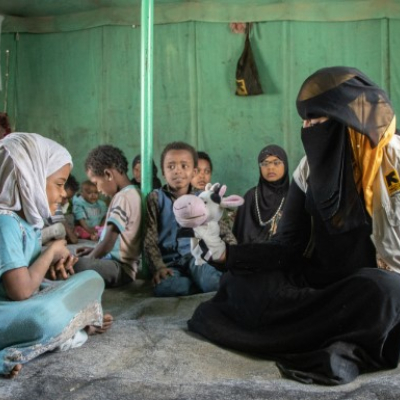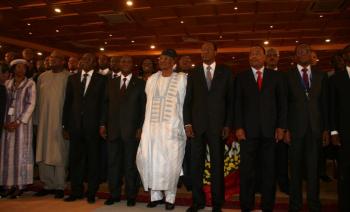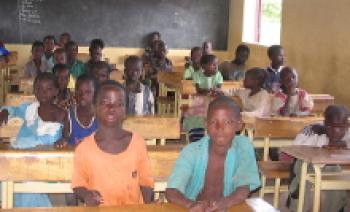The article is also available in French and Spanish.
One in three school-age boys and girls in Sudan are currently out of school according to UNICEF’s latest Humanitarian Action for Children1 brief. That’s almost 7 million children, with girls being the most affected. With the financial support of the EU, LM International partnered up with Save the Children Finland to implement the project entitled ‘Provision of safe, inclusive and quality education to conflict-affected and other vulnerable boys and girls in Central Darfur, West Darfur and South Kordofan.’2
From gender neutrality to gender inclusivity: a much-needed shift in perspective
According to Save the Children’s 2022 Risks to Education Index3, Sudan is ranked among the top four countries where education is at extreme risk, with one of the lowest girls’ enrolment rates in the world.4 Barriers to girls ’ education range from forced early marriage, insecurity due to conflict, tradition and cultural beliefs linked to a patriarchal society, to poverty and lack of adequate infrastructure.
LM International (which is part of EU-CORD, a network of Christian relief and development agencies) and Save the Children Finland have been working on fostering the empowerment of girls and women in conflict-ridden states like Sudan, so that more members of this often vulnerable group can access quality and equitable education in a safe way. The tools include facilitating children’s enrolment and teacher training programmes, engaging with communities throughout the implementation of the project (not just during the initial assessment phase), and actively involving parents in their children’s school life.
The project, implemented between June 2019 and May 2022, had to quickly re-adapt to the continuously shifting security situation and the unprecedented impact of COVID-19, especially on remote communities. Almost 42,000 school-age children, of which 55.3% were girls, were able to access quality education and learning opportunities, with more than 40,000 retained in the formal education system.
The project addressed one of the most important factors behind access to inclusive education: raising awareness of the importance of children’s education at the family and community level and thus initiating a shift in perceptions in a tradition-rich country like Sudan (or, at the very least, in parts of it). After all, inclusive and equitable education cannot just be measured in enrolment rates.
Lessons learnt from the LM International – Save the Children project
The project provided conflict-affected children in Central Darfur, West Darfur and South Kordofan with improved access to inclusive and protective education opportunities, in the immediate and long-term. Key lessons learnt include:
- Performing a thorough context assessment while remaining responsive to emerging challenges
- Engaging with communities: before, during and after
- Understanding that education cannot exist in a vacuum
1. Performing a thorough context assessment while remaining responsive to emerging challenges
Even before COVID-19 hit, the project team had come up with some of the most important activities (teacher training programmes) to be carried out online. As many teachers lived in remote areas, distance e-learning was the obvious solution.

When it came to implementing this specific activity, however, the lack of infrastructure (no access to high-speed internet in many areas and insufficient smartphones and computers) made it close to impossible to carry out the training programmes in the way they had originally been designed. This turned out to be a bigger challenge than initially anticipated: the implementing team had believed internet infrastructures would be more viable.
“You think you are designing a programme bearing in mind the challenge of not being able to see each other in person due to the lockdown during the pandemic. Then, you find out that there is no stable network for e-learning, there are no smartphones, no laptops, no computers, but teachers still need to be trained, children still need to be schooled. You have to readapt very quickly to respond to a challenge you did not expect.” Sally Magzoub, Project Manager, LM International.
Rapid adjustment to the new circumstances was needed and, in the end, the implementing team was able to arrange for some of the trainers to travel and carry out learning activities in the safest way possible given the situation at the time. “It was a lesson learnt for us,” says Sally Magzoub. “If you don’t fully know the situation on the ground, try not to include activities that may cause unexpected challenges during their implementation.”
2. Engaging with communities: before, during, after
Sudan is still a very patriarchal society. Forced early marriage, poverty, and insecurity are some of the reasons hindering girls’ access to inclusive, quality education. Families still prefer to invest in the education of boys rather than girls, although the situation has improved over the last twenty years.
Within the LM International and Save the Children project, a lot has been done to help parents understand the importance of education for both boys and girls. Community awareness was identified as one of the pivotal activities leading to equitable access to quality education. And there is always room for improvement: “We need to increase awareness-raising sessions and target additional areas,” explains Mugtaba Alsafi, Kordofan Area Coordinator for LM International. “We need to continuously engage with community leaders to try to convince them of the importance of their children going to school. We need to help them discuss sensitive issues that would normally be considered taboo, like early marriage and gender-based violence.” As he highlighted, girls need tailored support.

Zeinab Maymoon, one of the community leaders in the South Kordofan area, shared how important involving parents in the school life has been within the context of this project. There is a real sense of ownership in the community and a clear plan as to how to continue to make the school even better now that the project has ended. Parents, community members and teachers have been given the tools to be actively engaged in the children’s education and are also willing to address some of the toughest conversations. They are ready to pitch in, which is what will make the progress achieved so far sustainable in the long-term.
“Accountability and transparency… We owe that to the local communities. One thing we learnt from them is that once the various agencies carry out their assessments in the project design phase, they don’t come back to share their findings or actively engage with target communities. Community awareness, especially in a society like Sudan, was key. A lot of people needed to be informed about the importance of education of the girl-child and of school-age children. Communities need to be aware of the risks that children may face when they are not in school.” John Alumgbi, Education Officer, National Christian Development Organisation (NCDO).
3. Understanding that education cannot exist in a vacuum
There are a lot of issues that need to go hand in hand with training teachers and parents or rehabilitating school buildings. Sometimes, transport or food are overlooked. Project design should always attempt to create cross-sectoral synergies. For example, some thought should be given to the question of how to ensure that children attending school have access to a daily healthy meal or that those who live in extremely rural areas are offered transport to and from the school or shelter within the school, where possible.

School sanitation is another particularly important issue that LM International and its partners have been trying to tackle throughout the project, especially in responding to the needs which arose during the pandemic and in addressing the general lack of hygiene awareness and practices in the target communities, especially amongst girls.
“Education cannot be treated in a vacuum. For the process to work, we need to take into consideration everything around it as well… For example, most of these children who live in a semi-constant state of emergency have to walk very long distances to reach the closest school. And this can be dangerous for various reasons. We need to make it easy for them to attend classes; we need to be able to look into feeding options as well. We need to think about education as a full package. We need to acknowledge that in emergency circumstances, parents might not be able to feed their children or send them to school. We cannot completely push this responsibility onto them.” Denis Semakula, Country Director, LM International Sudan.
Final thoughts
While considerable progress has been made in filling the gender gap in education globally, especially when it comes to primary education, girls are still more likely to experience barriers to enrolment, particularly in Africa, the Middle East and South Asia.
Being strongly anchored locally has allowed LM International and its partners to reach remote communities and work with them to offer support. Not only are more boys and girls able to access safe and quality education, but the wider shift in perspective has been felt by the community. Parents and teachers are ready to play an active role in the children’s lives, even beyond education.
Special thanks for the support: Tabeth Masengu, Mugtaba Alsafi, Zeinab Maymoon and Isabella Olsson.
1 www.unicef.org/media/131721/file/2023-HAC-Sudan.pdf
2 Grant holder: Save the Children Finland. Implementing partners: Save the Children International - Sudan Country Office, Läkarmissionen/LM International, National Christian Development Organisation (NCDO), Zahra Center for Development, Jabal Marra Charitable organization for rural development (JMCO).
3 https://resourcecentre.savethechildren.net/document/build-forward-better-2022/
4 World Bank, 2020.
Recommend & share this article if you think it will be helpful to your peers
Click on the play button below to watch our video on gender inequalities
Additional information
Children’s Rights Clubs: a successful model to replicate
The LM International and Save the Children Finland project also included the creation of Children’s Rights Clubs. These provided a safe space for children to express their protection needs and concerns. Topics of discussion within these clubs were: personal hygiene and hygiene in the school and at home, measures against the spread of COVID-19, sexual and gender-based violence within the school environment, the right to education, and many more.
In order to support children, teachers were trained to promote a healthy and inclusive learning environment and to identify those who required additional attention. Training on child safeguarding, children’s rights, child protection and gender equality approaches allowed teachers to take appropriate and timely measures to meet children’s needs.








Log in with your EU Login account to post or comment on the platform.